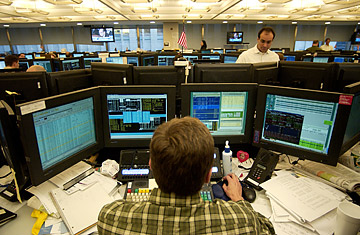
Traders work on the JPMorgan Chase Fixed Income and Foreign Exchange trading floor in New York City
The smart money these days isn't obsessing about the stock market — it's making huge bets against the euro and the Japanese yen.
Since the start of the year, the 16 European nations that make up the euro zone have watched their currency plunge to an eight-month low as a result of sovereign-debt panic. Greece, which is perhaps the weakest link in the European Union, was first to hit the wall on news that its deficit has ballooned to nearly 13% of GDP. Then last week, worry about debt default spread from Greece to Spain, Portugal and Ireland, where spending is similarly out of control.
"The euro bears most watching in 2010," says economist David Rosenberg of investment firm Gluskin Sheff & Associates in Toronto. "The fiscal situation in Greece and Portugal is the most significant test for the euro's expansion in at least a decade."
Meanwhile, Japan's central bank has finally conceded that deflation is a critical problem and signaled that Japanese interest rates will remain at historically low levels for at least the balance of 2010 as the government prepares to devalue its currency.
The economic malaise of the E.U. and Japan has central bankers and bondholders worried. But it has currency speculators and arbitragers licking their lips at the prospect of riding the euro and yen on their downward slide, while at the same time making fat profits on high-yield investments and rising currencies in emerging markets.
This sophisticated bit of financial wizardry is known as a carry trade, and it's a popular way to offset moves in equity and bond markets while also producing a handsome return.
The idea is to borrow money cheaply in one country and invest it in another with higher interest rates and where the currency may be appreciating. Last year a plunging dollar and the Fed's decision to slash rates made the U.S. currency ideal for funding carry trades. For example, selling the U.S. dollar to buy Australian dollars, Norwegian kroner and Brazilian reals yielded returns in excess of 30%.
But is this kind of big-money speculation by hedge funds and private-equity funds generally beneficial, or can it exacerbate an already bad situation in the real economy, just as derivatives did in the case of the subprime-mortgage meltdown?
Certainly the U.S. did not embrace the idea of carry trades being funded by the greenback, because this worked to only further weaken the dollar against major currencies, including the euro, the British pound and the Swiss franc. This made imports more expensive for consumers — at least in theory. (In reality, because of the size of the U.S. market, few importers could risk raising their prices for fear of being pushed out.)
Similarly, Greece and Spain are pushing back against speculators who want to short the euro or use it in carry trades, further depressing the already soft currency. Just this week Spain's Finance Minister, Elena Salgado, flew to London to assure bondholders that her country remains solvent and unveil a proposal to cut Spain's budget deficit to 3% of GDP by 2013.
But if the euro and yen are this year's dollar, what's on the flip side of the smart carry trade for 2010? Last year the Brazilian real was a currency on fire, appreciating 35% on interest rates that started 2009 at an unsustainable 13.75%. It was a situation that threatened to suffocate the economy, forcing the government to intervene in currency markets, cut interest rates nearly 40% and impose new taxes on foreign investment.
Colombia and Chile experienced similar, if less dramatic, run-ups in their currencies in 2009, and Latin America remains the region to watch in 2010. Greg Anderson, director of currency strategy at Société Générale Global Markets in New York likes Mexico best, noting its peso could repeat the performance of last year's hottest Latin-American currencies, helped by comparatively high interest rates, currently at 4.5% but expected to trend upwards to 5.75% by year end. Also, Mexico's government is pursuing a hands-off approach to currency markets.
Société Générale also likes Turkey and South Korea among emerging-market economies and Australia and New Zealand in the developed group.
So far the euro and yen top the list of must-watch "funding" currencies for 2010, but that prognosis might change as the year unfolds. Like Greece, both Britain and the U.S. have dangerously high levels of outstanding debt, largely due to stimulus spending and bailouts intended to get their respective economies back on their feet. While this might spell trouble for the dollar and British pound, it's a looming opportunity for those who ply the carry trade.
